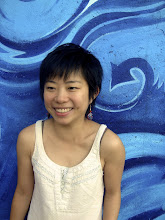This is not a review.
Saw Ishmael Houston-Jone's THEM at PS122 tonight, first staged in 1986(?) at the same location. As Ishmael stated in a facebook chain discussion, one of the reason it is re-staged the way it was, is to share the work with more audience. And I, as a new generation of audience member as well as young artist, would agree with that and even appreciate having the chance to see a good work that I otherwise wouldn't have the chance to see.
See? I just got robbed yesterday, in broad day light, by a 13-year-old kid. As I am still pondering human aggression and the large question of poverty and injustice, the aggressive and almost violent dancing didn't have any effect on me at all: I was surprised in a way. What caught me in the eye and left an impressive mark, was the subtle but highly suggestive juxtaposition. I like the way he puts things together. Simple repetition, doing something over and over again has its own power.. in one section as Dennis Cooper with his slighting depressing but matter of fact voice, described the suicidal deaths of gay young man, we simultaneously saw the image of a a young man swinging a wood block towards coins thrown in the air, as if he's practicing baseball in an empty garage. The sound of the coin hitting the metal ceiling of the theater, and the single strip of lighting suggested some potential terrible consequence that is about to happen, but we don't get to see it. It is definitely very disturbing and makes me more nervous than if they were to stage a real suicide or something similarly lame.
Another moment that touched me was when the two pairs of men were struggling and they looked like they could be in love or in a fight with each other. It's that fine line between physical violent and highly seductive sexuality. But the piece seems to be suggesting that violence is the way gay men express their sexuality, because it is the only way they can. Not a single moment in the piece did we see the other side of the spectrum: intimate, loving interactions among these men. There was one section when two performers had subtle but flirty exchanges, and led to another round of violent partnering. Anther moment of suggestive juxtaposition was with a recording of school boy hustles and voices in the school playground, and the adult male performers were all touching their pubic areas as if wondering who they were and who they are becoming...suggested curiosity and doubt in boys' puberty. simple repetitions like that tell such strong messages and that was the mastery of the show in my opinion... the dancing was good.. but after a while it's not interesting anymore and it's the pairing and way things are put in context and juxtapositions that made the show.
One of my questions is for the straight performers... just coz I know some performers in the show personally and know that they are not gay.. How do they connect and perceive who they are in the piece and the experiences that are being spoken by the work? Also, if we were to make an all-women piece about the experience of growing up as young women, for example, that would probably just be coined as straight-up feminist. Why is it any less interesting than doing it with men? Except that I have to say I really enjoyed seeing men interact physically and dance together. It is not a common image in our society, and therefore there's something really satisfying just seeing that... maybe i am just being a woman.




